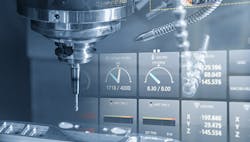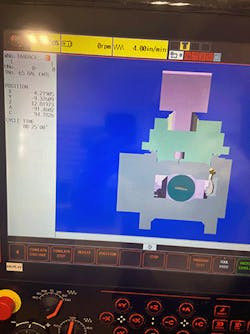Andy Watkins is sales application engineer at Knox Machinery in Hamilton, Ohio.
What have been the biggest improvements to machine-controls technology in the past five years?
Andy Watkins, sales application engineer, Knox Machinery: Some of the biggest machine controls improvements have been in the ability to import CAD files directly into the control and create a conversational program from the CAD file. This reduces the human error factor and makes writing a program simple and fast. This feature, on the machines that provide it, can write dozens of lines of code in seconds and still be correct to the model. Additionally, very complicated geometry can be created with a few clicks by less-experienced operators, which has the added benefit of relieving the workload off of programmers and engineers.
Also read: Think like a machinist
Figure 1: With the new controls that offer machine simulation built into the control, programs can be tested right on the machine with actual part models and work-holding models built into the simulation environment with just a few clicks.
What’s the most innovative or efficient machine-controls technology application you’ve ever seen or been involved with?
Andy Watkins, sales application engineer, Knox Machinery: One of the most innovative developments on machine controls is machine simulation on the control. Traditionally a programmer would take a given program and run it through a third-party machine-simulation software to verify the program so that machine crashes and part violations by cutting tools are prevented in a digital test of the actual machine-tool environment. These programs typically run into the tens of thousands of dollars and take special skill sets to utilize. With the new controls that offer machine simulation built into the control we can test programs right on the machine with actual part models and work-holding models built into the simulation environment with just a few clicks (Figure 1). If it passes the machine simulation test, the program and setup are good to go for production. We have even had customers that run several machines unattended once they have used the machine simulation to verify that nothing crashes.
How has machine-controls technology benefitted from remote monitoring and connectivity?
Andy Watkins, sales application engineer, Knox Machinery: The connectivity that we now find in many of the better machine controls is opening completely new realms of productivity. The ability to connect to the machine can be used, for example, to remotely monitor maintenance issues, as well as preventive measures that keep the machine running and in top shape. Most folks understand that if you do not schedule your maintenance the machines will schedule it for you at the worst possible time. With the ability to remote into the machine, maintenance engineers can connect directly with OEM technicians to assist with routine maintenance as well as unplanned events. This seems to be just the tip of the iceberg when it comes to all the options that are coming available through remote monitoring and connectivity.
Can you explain how software development has changed machine controls in discrete manufacturing?
Andy Watkins, sales application engineer, Knox Machinery: Software development has allowed machine controls to change by creating opportunities for manufacturers to integrate new and emerging technologies into the machine control on the floor. No longer are we bound to the NC-only platform on a machine. With the ability to merge two computers onto one control, new doors are open to developers as they create the next generation of productivity-driven technologies. As computers and computing have become more relevant in our manufacturing fields, we find them becoming more efficient than ever and creating opportunities to increase productivity in our highly technical world.
Andy Watkins, sales application engineer, Knox Machinery
How do control technologies figure into digital-twin platform models being used by manufacturers?
Andy Watkins, sales application engineer, Knox Machinery: Controls that offer machine simulation have a leg up on the digital-twin platforms that we see emerging. By having a working understanding of the machine and its digital twin that is on the control, we can begin to understand how to utilize the digital-twin technology from a practical and real-world point of view. Often, we begin to hear the buzzwords that surround our highly technical field; they can leave us wondering how to implement these new technologies into our particular situations. We want to be cutting-edge, but it all can sound fairly intimidating. This is where machine controls that offer at least a machine-simulation option on the control can help us get started in a practical way that will allow us to grow and evolve into these emerging and advanced technologies.
What future innovations will impact the use of machine-controls technology in discrete-manufacturing operations?
Andy Watkins, sales application engineer, Knox Machinery: With the advent of MTConnect and the IIoT, we are likely to see streams of data and data-management tools that help us understand common fail points and to recognize new opportunities for improvement. It seems that we will need to understand how our data can be leveraged to identify pertinent details of our daily operations in a greater way. Our need for data management will drive the development of these new streams of information and data-management tools that will pave the way for the future improvements in every aspect of the manufacturing world. Data will be able to be captured and utilized in new and innovative ways that will increase productivity, reduce machine down time and help us create profit in our manufacturing endeavors.
Tell us about your company’s state-of-the-art machine-controls technology for discrete manufacturing.
Andy Watkins, sales application engineer, Knox Machinery: Knox Machinery represents Mazak, which has introduced the Smooth control to the manufacturing world. The Smooth technology suite is a state-of-the-art product that greatly increases efficiency and throughput in manufacturing plants. The control features not only a great NC control, but also a full Windows-based computer in the same unit. This allows for an open architecture, which in turn allows third-party apps to be installed on the control. The most common example of a third-party app is Renishaw’s Set & Inspect product. Set & Inspect probing increases accuracy in manufacturing and the ease-of-use is second to none.
Mike Bacidore is the editor in chief for Control Design magazine. He is an award-winning columnist, earning a Gold Regional Award and a Silver National Award from the American Society of Business Publication Editors. Email him at [email protected].
About the Author
Mike Bacidore
Editor in Chief
Mike Bacidore is chief editor of Control Design and has been an integral part of the Endeavor Business Media editorial team since 2007. Previously, he was editorial director at Hughes Communications and a portfolio manager of the human resources and labor law areas at Wolters Kluwer. Bacidore holds a BA from the University of Illinois and an MBA from Lake Forest Graduate School of Management. He is an award-winning columnist, earning multiple regional and national awards from the American Society of Business Publication Editors. He may be reached at [email protected]

Leaders relevant to this article:




